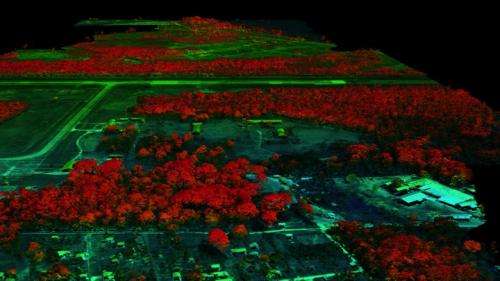Carnegie debuts revolutionary biosphere mapping capability at AGU

Researchers from the Carnegie Institution are rolling out results from the new Airborne Taxonomic Mapping System, or AToMS, for the first time at the American Geophysical Union (AGU) meetings in San Francisco. The groundbreaking technology and its scientific observations are uncovering a previously invisible ecological world. To watch a video about how AToMS is helping researchers look at the world in a whole new way, click here.
AToMS, which launched in June 2011, uniquely combines laser and spectral imaging instrumentation onboard a twin-engine aircraft to derive simultaneous measurements of an ecosystem's chemistry, structure, biomass, and biodiversity. AToMS includes a unique imaging spectrometer implemented by Carnegie scientists in close collaboration with engineers at the NASA Jet Propulsion Laboratory. In its inaugural year of operation, AToMS mapped tens of millions of acres of ecosystems in California, Panama, Colombia, Costa Rica, the Peruvian Andes, and the Amazon basin. New results presented at AGU have applications ranging from mitigating climate change to forest conservation and ecosystem management.
"The real power of what we are doing is that every image from AToMS yields a discovery that feels like looking into the universe for the first time," Asner said. "AToMS consistently reveals something we didn't know, and often many things we had never considered."
One AGU report led by Asner assessed the impacts of the 2010 mega-drought in the Amazon basin on the forest's structure, carbon stocks and biodiversity. Because the frequency of Amazonian droughts is predicted to increase in the future, understanding how the 2010 drought changed the forest is critically important to predicting the future of the region. Using the Carnegie Airborne Observatory's (CAO) AToMS system, Asner and his team revealed huge areas of drought-stressed vegetation in the Amazon, finding previously unknown impacts ranging in scale from individual branches to whole canopies among millions of rainforest trees.
Another CAO study led by Mark Higgins considered how Panamanian forests are patterned by the unique geology of the region. The results help to explain why Panamanian ecosystems remain some of the most biologically diverse in Central America. And a report by Stanford graduate student Dana Chadwick used AToMS to examine the terrain hidden beneath the Amazon rainforest canopy. Three-dimensional mapping revealed how the Amazon environment promotes the co-existence of so many rainforest species.
Chadwick summed it up: "It's like taking an x-ray of an entire landscape, plant by plant, and each tiny hill. We can see how just a one or two foot change in ground elevation can create a new habitat for rainforest species, with measurable effects on the rainforest biomass."
Other topics covered in the ten reports presented at the conference range from how California Mediterranean ecosystems are assembled, to the important role that streams play in helping forests to store global-warming gases such as carbon dioxide.
Woody Turner, NASA Program Scientist for Biological Diversity commented, "The combination of an imaging spectrometer and a laser scanning instrument inside CAO AToMS is proving to be an ideal solution to the challenge of remotely sensing biodiversity. AToMS gives us—on one airborne platform—instruments capable of simultaneously parsing the composition, function, and structure of ecosystems."
Asner agreed: "Probably the most profound scientific advances revolve around directly measuring biodiversity in some of the most critically endangered regions of our planet."
He specifically pointed to the reports led by Claire Baldeck and Jean-Baptiste Féret, two Carnegie scientists working with the airborne technology to map plant diversity in African savannas and Amazonian rainforests. Baldeck reported on the holy grail of ecology—finding how landscapes evolve to support different assemblages of plants. Féret, meanwhile, showed that subtle variation in Amazon forest soils and terrain impart huge differences in overall biological diversity – a measurement made possible for the first time by CAO AToMS.
Provided by Carnegie Institution for Science
















